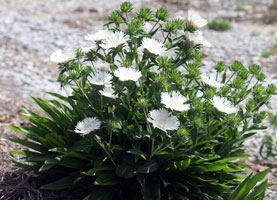8/27/2015
Success With Stokesia
Josiah Raymer

While some would call
Stokesia laevis a garden classic, today’s stokesias share little more than a name with the species—performance has far surpassed their roots. Prized for their color and habit, the new millennial selections enthusiastically fill gardens with their vigor and tidy habits, staying neatly upright and compact, unlike the species, which tends to fall open. At a compact 12 to 24 in., they provide extended enjoyment in both their long flowering and long lives.
Stokesia caters to the natives craze, too; they originate from the American southeast. The newest and most unique cultivars launch this perennial favorite even farther forward. Divinity has large flowers opening with a hint of yellow in the center, then maturing to pure, long-lasting white. It’s a favorite for butterflies and gardeners alike.
Colorwheel offers a similarly spectacular show, with 3-in. flowers emerging white and changing colors as they age—white turns to lavender and then to dark violet blue.
Mary Gregory serves up creamy yellow right on through fall and Mel’s Blue bursts with big 4-in. blooms, bringing periwinkle pow into August.
Stokesia, particularly Divinity, offers the staying power and adaptability to excel as cuts and potted plants alike. You’ll get a celestial charge out of it in cutting gardens, borders, native meadows, naturalized plantings and containers of all sizes. Typically hardy in Zones 5 to 9, they’re evergreen in mild winters, and with a little light shearing or deadheading, will come back for a second show.
Planting
Plant one plant per trade gallon pot into a media with good drainage. Plants will finish in approximately eight to 10 weeks for spring sale.
Growing media
Choose a well-draining commercial media.
Growing temperature
Provide greenhouse temperatures of approximately 75 to 90F (23 to 32C) days and approximately 45 to 55F (7 to 12C) nights. While many varieties—Divinity in particular—tolerate a wide range of conditions, including heat and humidity, cooler nights help maintain active growth.
Light
Stokesia prefer high lights levels of at least 5,000 foot candles or full sun. Supplemental lighting generally isn’t necessary.
Soil pH & EC
Maintain pH at approximately 5.8 to 6.2 and electrical conductivity (EC) at 0.8 to
1.2 mS/cm using the 2:1 extraction method.
PGRs and pinching
Spraying with approximately 2,000 ppm
B-Nine/1,000 ppm Cycocel plant growth regulator is effective. Stokesia generally do not need pinching.
Fertilizer
Provide a constant liquid feed at low levels
of 100 to 150 ppm or 0.75 to 1 lb. nitrogen per yard of slow release.
Vernalization requirements
Not required for flowering, but overwintered material will come out with vigorous growth.
Irrigation
Allow plants to dry between ample waterings. Keep soil evenly moist. Excess water
on the leaves may result in leaf spotting.
Pests and Diseases
Much like the species, generally pests and diseases are not a problem with today’s stokesia, provided standard sanitation practices are included in the production plan. Ensure a good preventive program is in place, including managing humidity levels and maintaining good air circulation.
Apply a broad spectrum fungicide drench at liner planting. You may follow a monthly broad spectrum fungicide control program, though breeding for better disease resistance has greatly reduced the need for fungicides.
GT
Josiah Raymer is head grower and general manager for Emerald Coast Growers, one of the country’s largest ornamental grass and perennial producers. He can be reached at (877) 804-7277, sales@ecgrowers.com or www.ecgrowers.com.